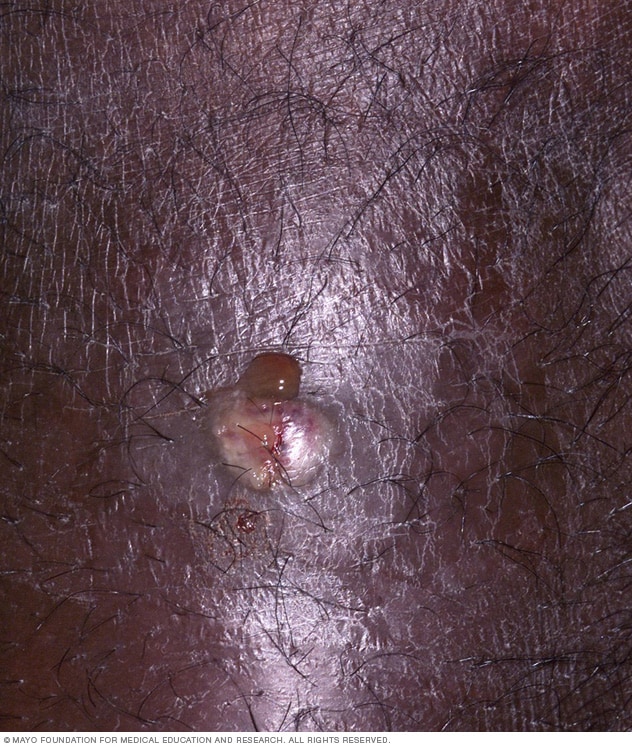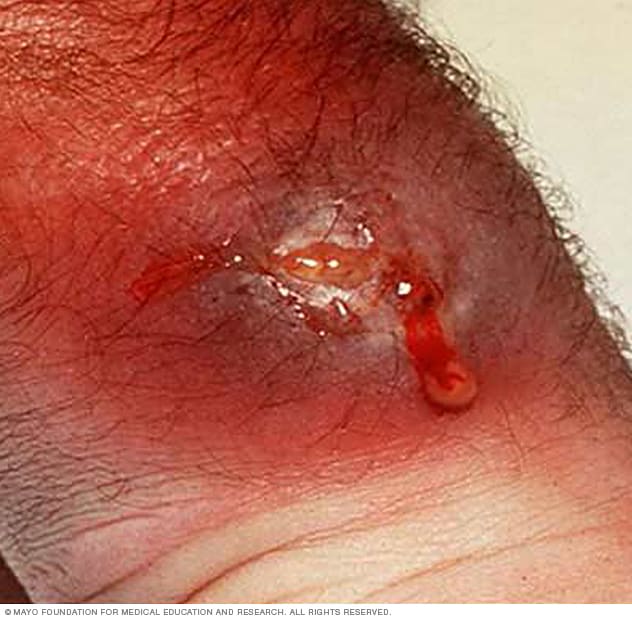Boils and carbuncles
Boils and carbuncles
overview
Cook

Cook
A boil is a painful, pus-filled bump under the skin - the result of a bacterial infection of one or more hair follicles.
carbuncle

carbuncle
A carbuncle is a collection of boils - painful, pus-filled bumps - that form a continuous area of infection under the skin.
A boil is a painful, pus-filled bump that forms under your skin when bacteria infect and inflame one or more of your hair follicles. A carbuncle is a collection of boils that form a continuous area of infection under the skin.
Boils (boils) usually start as reddish or purple, tender bumps. The bumps quickly fill with pus, becoming larger and more painful until they burst and drain. The face, neck, armpits, thighs and buttocks are particularly affected.
You can usually take care of a single boil at home. But don't try to poke or squeeze it - this can spread the infection.
Symptoms
boil
Boils can appear anywhere on your skin, but occur primarily on the face, neck, armpits, thighs, and buttocks—hairy areas where you are most likely to sweat or experience friction. Signs and symptoms of a boil usually include:
- Eine schmerzhafte, rote Beule, die klein beginnt und sich auf mehr als 5 cm vergrößern kann
- Rötliche oder violette, geschwollene Haut um die Beule herum
- Eine Zunahme der Größe der Beule über ein paar Tage, wenn sie sich mit Eiter füllt
- Entwicklung einer gelb-weißen Spitze, die schließlich reißt und den Eiter abfließen lässt
carbuncle
A carbuncle is a collection of boils that form a contiguous area of infection. Compared to single boils, carbuncles cause a deeper and more severe infection and are more likely to leave a scar. People who have a carbuncle often feel generally unwell and may experience fever and chills.
When to go to the doctor?
You can usually take care of a single, small boil yourself. But see your doctor if you have more than one boil at a time or if a boil:
- Tritt auf Ihrem Gesicht auf oder beeinträchtigt Ihr Sehvermögen
- Verschlimmert sich schnell oder ist extrem schmerzhaft
- Verursacht Fieber
- Wird trotz Selbstpflege größer
- Seit zwei Wochen nicht geheilt
- Wiederkehrend
Causes
Most boils are caused by Staphylococcus aureus, a type of bacteria commonly found on the skin and in the nose. A bump forms when pus collects under the skin. Boils sometimes develop in places where the skin has been broken by a small injury or insect bite, allowing the bacteria to easily penetrate.
Risk factors
Although anyone - including otherwise healthy people - can develop boils or carbuncles, the following factors can increase your risk:
- Enger Kontakt mit einer Person, die eine Staphylokokkeninfektion hat. Es ist wahrscheinlicher, dass Sie eine Infektion entwickeln, wenn Sie mit jemandem zusammenleben, der ein Furunkel oder Karbunkel hat.
- Diabetes. Diese Krankheit kann es Ihrem Körper erschweren, Infektionen zu bekämpfen, einschließlich bakterieller Infektionen Ihrer Haut.
- Andere Hauterkrankungen. Da sie die Schutzbarriere Ihrer Haut schädigen, machen Hautprobleme wie Akne und Ekzeme Sie anfälliger für Furunkel und Karbunkel.
- Beeinträchtigte Immunität. Wenn Ihr Immunsystem aus irgendeinem Grund geschwächt ist, sind Sie anfälliger für Furunkel und Karbunkel.
Complications
Rarely, bacteria from a boil or carbuncle can enter your bloodstream and travel to other parts of your body. The spreading infection, commonly known as blood poisoning (sepsis), can lead to infections deep within your body, such as: B. Heart (endocarditis) and bones (osteomyelitis).
prevention
It's not always possible to prevent boils, especially if you have a weakened immune system. But the following measures can help you avoid staph infections:
- Waschen Sie Ihre Hände regelmäßig mit milder Seife. Oder verwenden Sie häufig ein Handdesinfektionsmittel auf Alkoholbasis. Sorgfältiges Händewaschen ist Ihre beste Abwehr gegen Keime.
- Wunden bedeckt halten. Schnitte und Schürfwunden sauber halten und mit sterilen, trockenen Verbänden abdecken, bis sie verheilt sind.
- Vermeiden Sie es, persönliche Gegenstände zu teilen. Teilen Sie keine Handtücher, Laken, Rasierer, Kleidung, Sportgeräte und andere persönliche Gegenstände. Staphylokokkeninfektionen können sich sowohl über Gegenstände als auch von Mensch zu Mensch ausbreiten. Wenn Sie einen Schnitt oder eine Wunde haben, waschen Sie Ihre Handtücher und Bettwäsche mit Waschmittel und heißem Wasser mit Bleichmittelzusatz und trocknen Sie sie in einem heißen Trockner.
Sources:
- Spelman D. et al. Zellulitis und Hautabszess: Klinische Manifestationen und Diagnose. https://.uptodate.com/contents/search. Abgerufen am 1. August 2019.
- Downey K. et al. Schnitt- und Drainagetechnik bei Hautabszessen. https://www.uptodate.com/contents/search. Abgerufen am 1. August 2019.
- Wie man Furunkel und Gerstenkörner behandelt. Amerikanische Akademie für Dermatologie. https://www.aad.org/public/skin-hair-nails/skin-care/boils-and-styes. Abgerufen am 1. August 2019.
- Habif TP. Bakterielle Infektionen. In: Klinische Dermatologie: Ein Farbleitfaden für Diagnose und Therapie. 6. Aufl. Elsevier; 2016. https://www.clinicalkey.com. Abgerufen am 1. August 2019.
- Mukwende M, et al. Grundlagen. In: Mind the Gap: A Handbook of Clinical Signs in Black and Brown Skin. St. George’s University of London; 2020. https://www.blackandbrownskin.co.uk/mindthegap. Abgerufen am 13. Juli 2021.
- Kelly AP, et al. Bakterielle Infektionen. In: Taylor und Kelly’s Dermatology for Skin of Color. 2. Aufl. McGraw-Hill-Bildung; 2016. https://accessmedicine.mhmedical.com. Abgerufen am 13. Juli 2021.

 Suche
Suche
 Mein Konto
Mein Konto